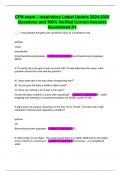Test Bank - Foundations of Mental Health Care, 6e (Morrison-Valfre, 2017)
Chapter 01: The History of Mental Health Care
Morrison-Valfre: Foundations of Mental Health Care, 8th Edition
MULTIPLE CHOICE.
1. The belief of the ancient Greek philosopher Plato that the rational soul controlled the
irrational soul could be compared with the belief of the more recent psychological theorist:
a. Freud
b. Pinel
c. Fisher
d. Rush
ANS: A
Sigmund Freud believed that mental illness was, in part, caused by forces both within and
outside the personality. Philippe Pinel advocated acceptance of mentally ill individuals as
human beings in need of medical assistance. Alice Fisher was a Florence Nightingale nurse
who cared for the mentally ill, and Dr. Benjamin Rush was the author of the book Diseases of
the Mind.
PTS: 1 DIF: Cognitive Level: Comprehension REF: p. 4
OBJ: 2 TOP: Early Years of Mental Health
KEY: Nursing Process Step: Assessment MSC: Client Needs: Psychosocial Integrity
2. During the mid-1500s, behaviors associated with mental illness were more accurately
recorded by professionals. This practice led to for different abnormal
behaviors.
a. Classifications
b. Diagnosing
c. Treatment
d. Education
ANS: A
Classification of abnormal behaviors did not begin until this time, after the practice of more
accurate recording of behaviors was begun. Diagnoses, treatment guidelines, and any
education regarding mental health disorders were not available during this period.
PTS: 1 DIF: Cognitive Level: Knowledge REF: p. 5
OBJ: 3 TOP: Mental Illness During the Renaissance
KEY: Nursing Process Step: Assessment MSC: Client Needs: Psychosocial Integrity
3. During the latter part of the eighteenth century, psychiatry became a separate branch of
medicine, and inhumane treatment was greatly diminished by the French hospital director:
a. Dix
b. Beers
c. Pinel
d. Carter
ANS: C
1|Page
, Test Bank - Foundations of Mental Health Care, 6e (Morrison-Valfre, 2017)
Philippe Pinel advocated acceptance of the mentally ill, as well as proper treatment. Dorothea
Dix crusaded for construction of mental health hospitals. Clifford Beers wrote the book A
Mind That Found Itself. President Jimmy Carter established the President’s Commission on
Mental Health in 1978.
PTS: 1 DIF: Cognitive Level: Knowledge REF: p. 5
OBJ: 4 TOP: Mental Illness in the Eighteenth Century
KEY: Nursing Process Step: Assessment MSC: Client Needs: Psychosocial Integrity
4. In 1841, surveyed asylums, jails, and almshouses throughout the United
States, Canada, and Scotland and is credited with bringing about public awareness and reform
for the care of the mentally ill.
a. Sigmund Freud
b. John Cade
c. Florence Nightingale
d. Dorothea Dix
ANS: D
Dorothea Dix spent 20 years surveying facilities that housed mentally ill individuals and is
credited with major changes in the care of the mentally ill. Sigmund Freud introduced the
concept of psychoanalysis, John Cade discovered lithium carbonate for the treatment of
bipolar disorder, and Florence Nightingale trained nurses in England in the 1800s.
PTS: 1 DIF: Cognitive Level: Knowledge REF: p. 6
OBJ: 4 TOP: Mental Illness in the Nineteenth Century
KEY: Nursing Process Step: Assessment MSC: Client Needs: Psychosocial Integrity
5. As a direct result of Clifford Beers’ work and book, A Mind That Found Itself, the Committee
for Mental Hygiene was formed in 1909 with a focus on prevention of mental illness and:
a. Early detection of symptoms of mental illness
b. Education of caregivers
c. Current treatment options
d. Removing the stigma attached to mental illness
ANS: D
Clifford Beers’ book reflected on his attempt at suicide followed by the deplorable care he
received for the next 3 years in mental hospitals. Beers’ work and book raised the
consciousness of people throughout the country regarding prevention and removal of the
stigma of having a mental illness. Early detection of symptoms, education of caregivers, and
current treatment options regarding mental illness were not the focus of his book, nor were
they a priority for the Committee for Mental Hygiene.
PTS: 1 DIF: Cognitive Level: Knowledge REF: p. 6
OBJ: 4 TOP: Mental Illness in the Twentieth Century
KEY: Nursing Process Step: Assessment MSC: Client Needs: Psychosocial Integrity
6. During the 1930s, what common treatment for schizophrenia caused clients to fall into a coma
that could last as long as 50 hours?
a. Electroconvulsive therapy
b. Insulin therapy
c. Humoral therapy
2|Page
, Test Bank - Foundations of Mental Health Care, 6e (Morrison-Valfre, 2017)
d. Amphetamine therapy
ANS: B
Insulin therapy was believed to successfully treat schizophrenia in the early 1900s.
Amphetamines were used to treat depression, and electroconvulsive therapy was used for
severe depression. Humoral therapy, which originated in ancient Greece and Rome, was a
belief that mental illness resulted from an imbalance of the humors of air, fire, water, and
earth.
PTS: 1 DIF: Cognitive Level: Knowledge REF: p. 8
OBJ: 5 TOP: Influences of War on Mental Health Therapies
KEY: Nursing Process Step: Assessment MSC: Client Needs: Psychosocial Integrity
7. In the 1930s, what mental health disorder was electroconvulsive therapy (ECT) most often
used to treat?
a. Schizophrenia
b. Bipolar disorder
c. Severe depression
d. Violent behavior
ANS: C
ECT was found to be an effective treatment for severe depression in the 1930s. During this
period, schizophrenia was treated with insulin therapy, and violent behavior was treated with a
lobotomy. In 1949, lithium carbonate was discovered as a treatment for bipolar disorder.
PTS: 1 DIF: Cognitive Level: Knowledge REF: p. 6
OBJ: 5 TOP: Influences of War on Mental Health Therapies
KEY: Nursing Process Step: Assessment MSC: Client Needs: Psychosocial Integrity
8. In the early twentieth century, a frontal lobotomy was a common treatment for violent
behaviors. Which description of this procedure is accurate?
a. A procedure that delivers an electrical stimulus to the frontal lobes of the brain
b. A surgical procedure that drills holes in the front of the skull to drain fluid
c. A surgical procedure that severs the frontal lobes of the brain from the thalamus
d. A surgical procedure that inserts implants into the frontal lobes of the brain
ANS: C
A frontal lobotomy is a surgical procedure in which the frontal lobes of the brain are severed
from the thalamus.
PTS: 1 DIF: Cognitive Level: Knowledge REF: p. 6
OBJ: 5 TOP: Influences of War on Mental Health Therapies
KEY: Nursing Process Step: Assessment MSC: Client Needs: Psychosocial Integrity
9. Which class of drugs was introduced in the 1930s for the treatment of depression?
a. SSRIs
b. Tricyclic antidepressants
c. MAOIs
d. Amphetamines
ANS: D
3|Page
, Test Bank - Foundations of Mental Health Care, 6e (Morrison-Valfre, 2017)
In the 1930s, amphetamines were found to boost the spirits of depressed people. SSRIs,
tricyclic antidepressants, and MAOIs are antidepressant agents, but they were not discovered
until much later.
PTS: 1 DIF: Cognitive Level: Knowledge REF: p. 6
OBJ: 5 TOP: Influences of War on Mental Health Therapies
KEY: Nursing Process Step: Assessment MSC: Client Needs: Psychosocial Integrity
10. In 1937, Congress passed the Hill-Burton Act, which was significant for the treatment of
mental health because it funded:
a. Research on drugs for the treatment of mental health disorders
b. Training of mental health professionals
c. Construction of psychiatric units in facilities throughout North America
d. Development of community mental health clinics
ANS: C
The Hill-Burton Act provided money for the construction of psychiatric units in the United
States. Research on drugs was not a part of the Hill-Burton Act. Training of mental health
professionals was funded by the National Mental Health Act of 1946, and community mental
health centers were not instituted until the 1960s.
PTS: 1 DIF: Cognitive Level: Knowledge REF: p. 6
OBJ: 5 | 9 TOP: Influences of War on Mental Health Therapies
KEY: Nursing Process Step: Assessment MSC: Client Needs: Psychosocial Integrity
11. The National Mental Health Act of 1946 provided a means for funding of programs that
promote research on mental health and:
a. Development of mental health clinics in the community
b. Training of mental health professionals
c. Treatment for veterans suffering from mental health disorders
d. Educating the public about mental illness
ANS: B
The National Mental Health Act of 1946 provided much needed training for individuals who
cared for patients with mental health disorders. Community mental health clinics were
initiated in the 1960s, treatment for veterans was not funded by this act, and education of the
public occurred later.
PTS: 1 DIF: Cognitive Level: Knowledge REF: p. 6
OBJ: 5 | 9 TOP: Influences of War on Mental Health Therapies
KEY: Nursing Process Step: Assessment MSC: Client Needs: Psychosocial Integrity
12. Which of the following best describes the disorder that was first recognized in veterans
following the Korean and Vietnam Wars?
a. Depression
b. Bipolar disorder
c. Post-traumatic stress disorder
d. Paranoid schizophrenic disorder
ANS: C
4|Page






